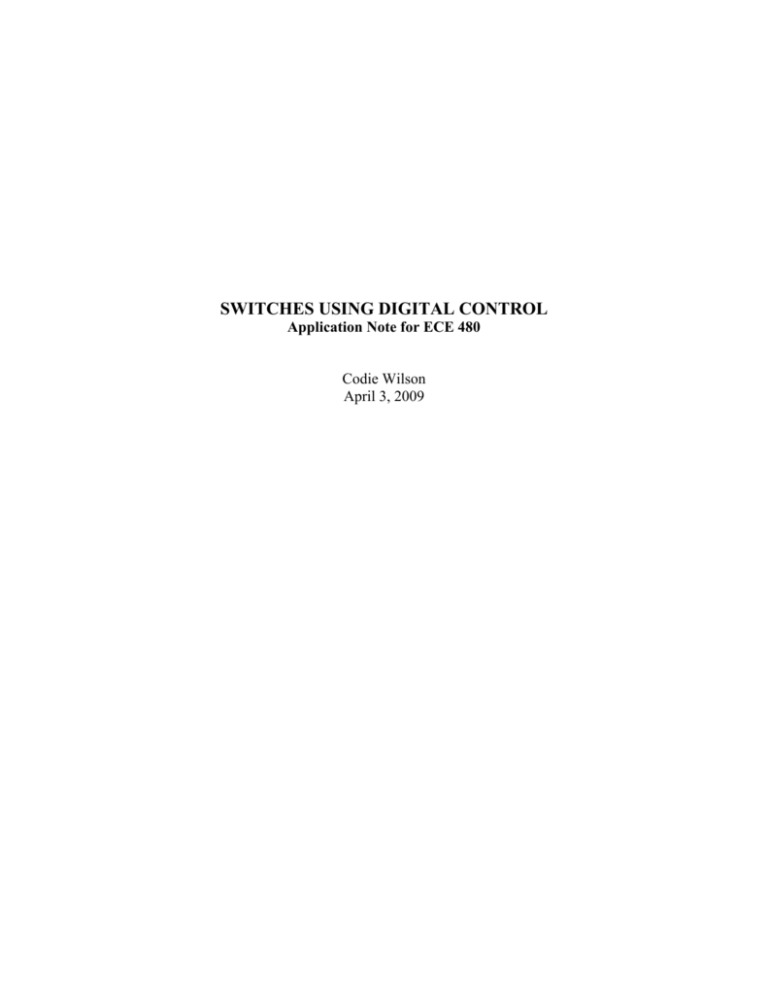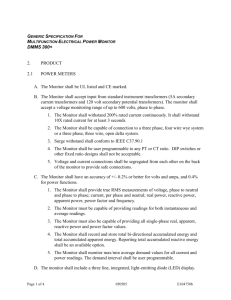Switches w/ Digital Control
advertisement

SWITCHES USING DIGITAL CONTROL Application Note for ECE 480 Codie Wilson April 3, 2009 OUTLINE I. Executive summary II. Keywords III. Objective of application note IV. Introduction V. Decoders VI. VII. VIII. - How they work - Design Considerations Analog Switches - How they work - Design Considerations - Pros/Cons Relays - How they work - Design considerations - Pros/Cons Application- Design Team 6 Project - Project description - Using the decoder - How and when to use analog switches - How and when to use relays IX. Conclusion X. References EXECUTIVE SUMMARY ECE 480 Design Team 6 has been tasked with automating a series of tests for an electronic fan clutch actuator. Current testing methods require physically switching between tests and the use of hand-held meters to conduct tests one at a time. Using digital logic and electronic switches makes it easy to automate the process of connecting a device under test with different metering circuitry. KEYWORDS Decoder, analog switch, relay OBJECTIVE There are two objectives of this application note. The first is to give examples of a few switch and switching control circuits available. Each has its pros and cons, which will be discussed. The second objective is to give a real example where and how these could be used, when to choose what, and some issues to consider in the design process. INTRODUCTION Switching is very important in many types of electronics. From the ignition in a car to a light fixture in a home, many of the devices used in every day life need to be “turned on.” In many applications, a mechanical switch is used, especially when it is used as the connection to a power source. However, there are ways to manipulate the path of electricity without “flipping a switch.” A decoder is an example of a fundamental circuit structure created for the purpose of controlling digital signals, while analog switches and relays are used to control the path of analog signals. Using these structures together, it is possible to design a method for routing electrical signals (large and small) by digital control, eliminating the need for manual switching. DECODERS Conceptually, a decoder has very simple functionality. It has control input lines that are either at a high or low voltage. It also has output lines that are either at a high or low voltage. If a decoder has M input lines, then it will have 2^M output lines. Only one of the output lines is high at any time, while all others are low. What determines that is the combination of high and low signals applied at the control inputs. For example, one common decoder is the MM74HC4514N integrated circuit. It has inputs A,B,C,D, and outputs S0-S15. The inputs are “high” if the voltage applied at the input pin is >75% of VDD, and they are low when the voltage is <25% (approximately). A high output signal is VDD-0.1V, and a low output is 0.1V. A high output signal can supply 25mA as well. Looking at the logic table or diagram (above) for the decoder, S0 is high when no input is high, S15 is high when all inputs are high, and there is every combination in between. Decoders are useful for logic switching. A decoder output can be used to drive the gate to an analog switch, or drive the base of a transistor. They are not generally made for supplying high current. The decoder, as mentioned above, can output up to 25mA per output, which is more than enough for many logic applications that rely mainly on voltage, but not enough to, for example, directly switch a relay. It may be necessary to use the signal from a decoder to power another switch, such as a transistor, which can allow much more current to flow through its terminals. This is easy to do, but still requires extra hardware. ANALOG SWITCHES An analog switch is used to pass a signal from its input to its output or vice versa (bidirectional functionality). This signal can be any type of electrical signal. An analog switch consists of an input, output and gate signal. The gate signal is driven by high and low voltage signals. The DG201B/202B series integrated circuit is an array of four analog switches, each having its own gate. The 201B is a “normally-closed” switch that passes signals when the gate has a low voltage, while the 202B is “normally-open” and passes signals when the gate has a high voltage. A high gate voltage is >2.4V and a low voltage is <0.8V. It can pass almost the entire range of voltage from supply to ground, and can handle up to 30mA of current through the switch. Analog switches are a very convenient choice for many applications. A switch gate can usually be directly driven by a logic signal and will draw almost no current (normally micro amps). That makes them very easy to control. They do have their drawbacks though. First, they are not normally made to handle high currents. 30mA may be enough for some applications, but for many it will not be. Also, there is a nonlinear resistance (R_on) associated with the connection between input and output. It changes based on the supply voltage. For the 201/2B series, R_on is typically 45 Ohm. It may be negligible, and it may not be, depending on how it is used and the values of the other resistors in the circuit. RELAYS A relay is actually a moving switch inside its packaging. A basic relay consists of a coil, yoke, armature, spring and a set of contacts. When current flows through the coil, it produces a magnetic field. The coil is wrapped around a yoke, commonly an iron core, that provides low resistance to magnetic flux. When enough current is flowing through the coil and a strong enough field is produced, it attracts the armature toward itself, moving it into a position where it connects the contacts. Most of the time it will make an audible clicking sound. The coil is not actually connected to the armature, so the switching signal (current through the coil) is independent of the signal moving between the contacts via the armature. As an example, the NEC EC2-5NJ series relay has a single coil that controls two sets of contacts. Each set of contacts has three pins: one is an input, one is connected to the input when the armature is at rest, and one is connected to the input when the armature is switched due to the coil current. For switching to take place, there needs to be at least 28mA through the coil at 5V (for this relay), but that varies depending on the voltage applied. There is a table in the datasheet that gives actual values. Relays have some very nice properties. As previously mentioned, the circuitry used to power the coil is physically separated from the signal the relay is passing. Since it is basically just connecting two contacts with a piece of metal, it can also handle much higher voltages and currents. The EC2-5NJ is rated for 2A at 220VDC, far exceeding a normal analog switch. Also unlike analog switches is that the relay offers almost no resistance (50 mOhm in this case). The drawbacks are that it takes a lot more power to switch, more than most ICs can give. A driver or high-beta transistor can be used to power the coil. Since it is a mechanical switch, it has a shorter lifetime (typically 10^6 operations) and is physically larger than an analog switch. APPLICATION An application where these are useful is in Design Team 6’s project: the design of a PC-based, automatic fan clutch actuator inspection device. The goal of the project is to create metering circuitry (not discussed in detail here) that the actuator can connect to through its six-pin electronic port. The metering circuitry needs to connect to different pins at different times and take different measurements, so switching is needed. Since the whole process needs to be automated, a method is needed to control the switching from a PC. For the interface between a PC and the metering circuitry, the NI USB-6008 data acquisition module was used. It connects to a PC through USB. On the module, there are 16 analog I/O connections and 12 digital I/O connections. The analog and digital I/O can be controlled through NI LabView software and can be automated if programmed to do so. The digital I/O will be used to control the switching in the metering circuitry. However, since there are more than 12 switching operations necessary, a decoder is used. Four of the digital outputs from the module are connected to four control lines on a decoder, and the decoder now creates 16 digital outputs from four. Which one of the 16 is used is dependent on which control lines are high, as explained in the decoder section. Now that enough digital outputs can be created for all the switching necessary, the actual switches need to be implemented. As previously mentioned, with analog switches, when the gate is high, the in/out terminals of the switch act simply as a resistor in the path of the circuit with a value of R_on. The datasheet on the DG201B gives application examples to show in more detail how the switch works and how to incorporate R_on into the calculations. The gates can be driven by the digital signal from the decoder. The best time to use these switches is when there will only be low current (<30mA) flowing through them, voltage that does not exceed ~24V, and where the R_on will not adversely affect the operation of the circuit. In certain cases, high current or voltage needs to be passed, or part of the circuit needs to be directly connected to ground with no resistance in series. Relays should be used. The digital output from a decoder does not have enough current to power the coil of a relay. The output can be connected to the base of a transistor that has its collector connected to the supply voltage and its emitter connected to the relay coil (the coil has to be grounded on the other side to allow current to flow through the transistor and coil when the transistor is “on”). A good choice for a transistor here would be the 2N2222 NPN transistor. CONCLUSION Hopefully it is easy to see how digital control can be used to switch circuit components. These three basic structures can allow an engineer to create many things, like a PC-based automatic inspection device, a precision amplifier with digitally programmable input and gains, or an active filter with digitally controlled break frequencies. The last two are examples of applications given in the DG201B datasheet. REFERENCES National Instruments USB-6008 datasheet, http://www.ni.com/pdf/products/us/20043762301101dlr.pdf Vishay Siliconix DG201B/202B datasheet, http://www.vishay.com/docs/70037/dg201b.pdf Fairchild Semiconductor MM74HC4514N datasheet, http://www.fairchildsemi.com/ds/MM/MM74HC4514.pdf NEC EC2 Series datasheet http://www.datasheetcatalog.org/datasheet/nec/EC2-3TNJ.pdf “How Relays Work” by Madeline Bullock, http://electronics.howstuffworks.com/relay.htm





